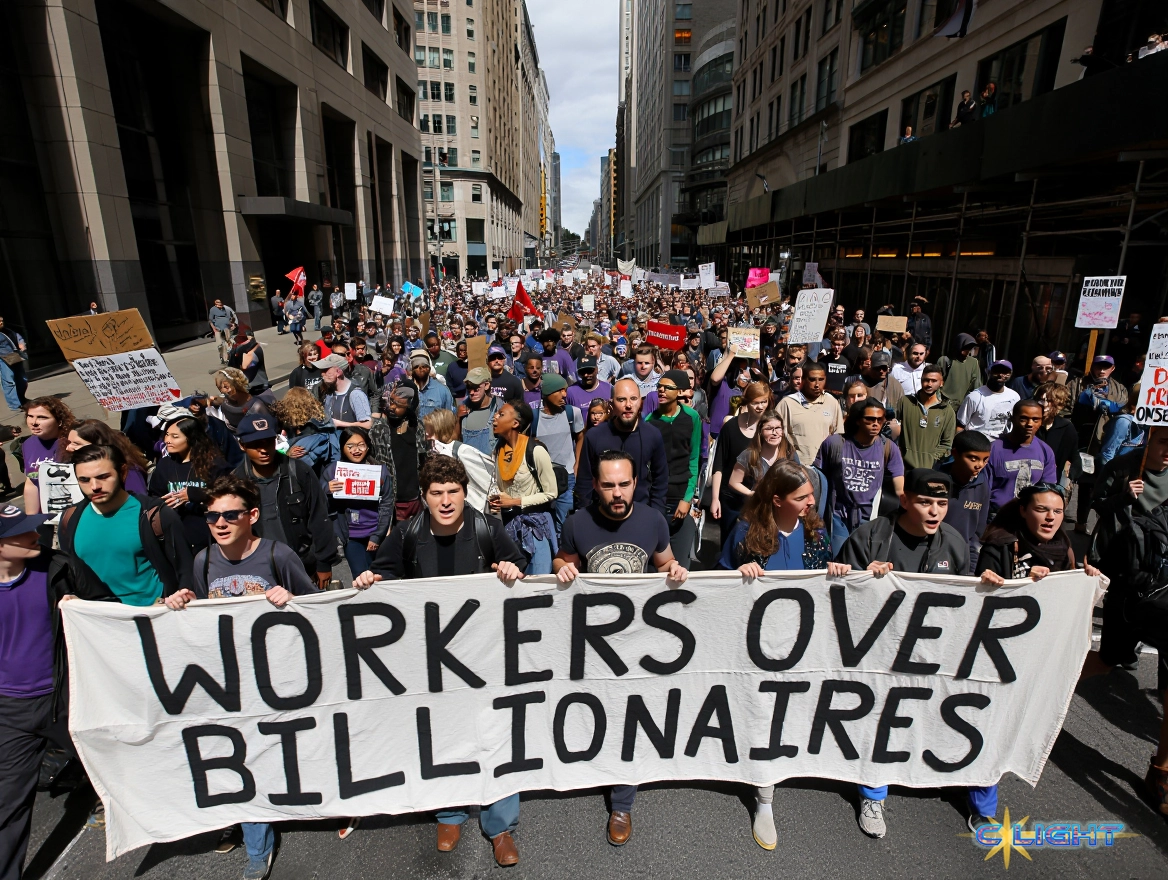4 minutes read time.
It was not your father’s Labor Day parade. Across the nation, the traditional, sleepy end-of-summer holiday was transformed on Monday into a fiery, organized, and deeply ornery “Day of Action.” Led by the AFL-CIO, the country’s largest federation of labor unions, and a broad coalition of progressive groups, more than 1,000 protests took place under a single, defiant banner: “Workers Over Billionaires.” This was not a single-issue protest; it was the physical manifestation of a profound and growing public rage against a system it sees as fundamentally rigged, a direct response to the Felonious Punk administration’s threats against federal workers, its proposed cuts to Medicaid and Social Security, and its authoritarian overreach in cities across the country. It was a sustained and increasingly sophisticated movement that, after months of quiet organizing, found its strategic muscle and began to flex it.
The Epicenter of Defiance: A Tale of Three Cities
Nowhere was the spirit of this new “good trouble” more potent than in the cities that have been the primary targets of the President’s vitriol. In Chicago, a city with a deep and bloody history of labor activism, marchers gathered at the Haymarket Memorial—the birthplace of the fight for the eight-hour workday—to send an unmistakable message of defiance. Their route was a deliberate act of protest in itself, a march that would snake through the Loop to the doorsteps of corporations like Target, Tesla, and Valor Equity Partners—a private equity firm directly linked to the administration’s controversial “Department of Government Efficiency.” In Los Angeles, citizens were still seething after one of the administration’s cronies, Kristi Noem, had the gall to claim the president had “saved” their city, a comment that acted as a powerful organizing tool for the opposition. And in New York, thousands of restaurant workers staged a “restaurant in the street,” serving tacos to the public to symbolize the acronym TACO: “Trump Always Chickens Out.” It was a brilliant piece of political theater—creative, memorable, and deeply cutting, a tactic that used humor and community to make a powerful political point.

From Emotion to Strategy: A Movement Matures
Monday’s nationwide protests were the culmination of a movement that has spent the last several months quietly shifting from raw, emotional reaction to focused, long-term strategy. As Gloria J. Browne-Marshall, a professor at John Jay College of Criminal Justice, noted, “The idea of protest as an effective tool regained its footing.” It is a response, organizers say, to the “extraordinary damage being sustained across every front that we care about,” from civil liberties to economic security. After a series of large-scale protests earlier in the year, organizers are now building a more durable infrastructure of dissent. Groups like Indivisible are launching projects to train a million new community organizers, a clear sign that the goal is no longer just to win a news cycle, but to build lasting political power. “That outrage is still there,” Browne-Marshall argued, “but now it’s going to be funneled and channeled into strategies and tactics on how we actually make change in the government.” The objective was clear: to make elected officials at every level “feel uncomfortable maintaining the stance they have.”
A National Reckoning
The most significant aspect of the protests was their sheer breadth. This was not just a “blue city” phenomenon. As organizers noted, dozens of these events took place in small towns and in counties that voted overwhelmingly for the Felonious Punk. This shatters the administration’s attempts to dismiss this as the noise of coastal elites. The core economic message—that the system is rigged for the ultra-wealthy at the expense of working people—resonated far more broadly than the White House would be comfortable admitting. The tactical diversity of the movement was on full display, from Boston’s first-ever Labor Day Parade to the “Bridge the Gap” activists dropping banners from highway overpasses in South Carolina. In many towns, the anger was channeled into community-building, with family-friendly picnics and back-to-school supply drives. As AFL-CIO President Liz Shuler declared, the goal was to “put the labor back in Labor Day.” It was a powerful attempt to reclaim the holiday from the commercialism of “mattress sales” and return it to its radical roots as a celebration of workers’ power, and a clear sign that a new and formidable season of “good trouble” has begun.
Discover more from Clight Morning Analysis
Subscribe to get the latest posts sent to your email.










